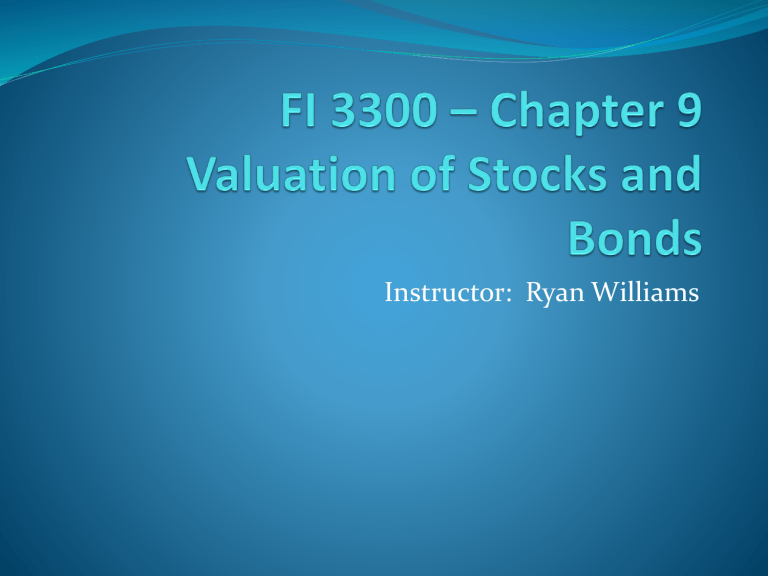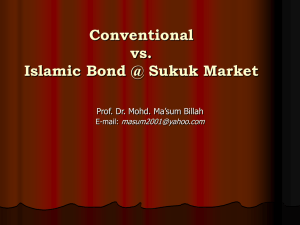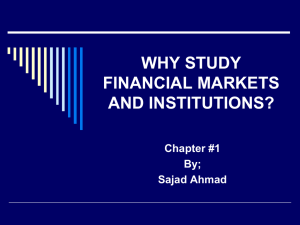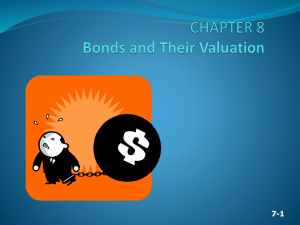FI 3300 * Chapter 9 Valuation of Stocks and Bonds

Instructor: Ryan Williams
Learning Objectives
Value a bond given its coupon rate, par value, yield-tomaturity, time to maturity and payment frequency.
Given all but one of the factors of a bond’s value, find the remaining factor.
Value a stock using the dividend discount model under assumptions of constant growth and non-constant growth.
Given all but one of the factors of a stock’s value, find the remaining factor.
Remember – different words for the same thing
Cost of capital (from firm’s point of view) = required rate of return (from investor’s point of view) = interest rate in problems.
Cost of debt = investor’s required rate of return on debt
Cost of equity = investor’s required rate of return on equity.
What is a financial security?
It’s a contract between the provider of funds and the user of funds.
The contract specifies the:
amount of money that has been provided
terms & conditions of how the user is going to repay the provider
Provider: you (ordinary investor), the bank, venture capitalist, etc.
User: entrepreneur or firm with good business idea/product but no (or not enough) money to execute the idea.
TVM and valuing financial securities
To an investor who owns a financial security (a stock or a bond), the security is a stream of future expected cash flows.
The value of any security is the Present Value of all the future expected cash flows from owning the security, discounted at the appropriate discount rate (required rate of return).
When we learn to value stocks and bonds later, we are just applying TVM concepts we already know.
Common financial securities
Debt security
1) Holder is a creditor of the firm.
No say in running of the firm.
2) Fixed payment.
3) Receives payment before anything is paid to equity holders.
4) If firm cannot pay, debt holders will take over ownership of firm assets.
5) Limited liability.
Equity security
1) Holder is an owner of the firm.
Have a say in running of the firm
(by voting).
2) Payment is not fixed. No guaranteed cash flow from firm.
3) Receives what’s left over after all debt holders/creditors are paid.
4) If firm cannot pay debt holders, loses control of firm to debt holders.
5) Limited liability.
Types of debt securities
Fixed-coupon bonds
Zero-coupon bonds
Consols (Perpetual bonds)
Variable-rate bonds
Income bonds
Convertible bonds
Callable bonds
Fixed coupon bonds
Firm pays a fixed amount (‘coupon’) to the investor every period until bond matures.
At maturity, firm pays face value of the bond to investor.
Face value also called par value. Most common face value is $1000.
Period: can be year, half-year (6 months), quarter (3 months).
How to read a bond
General Motors 30 year bond
Par Value = $1000
Interest paid Semi-annual
Interest Rate = 8%.
Zero coupon and consul bonds
Zero-coupon bond
Zero coupon rate, no coupon paid during bond’s life.
Bond holder receives one payment at maturity, the face value.
Consol bond
Pays a fixed coupon every period forever.
Has no maturity.
Other types of bonds
Variable-rate bond: Coupon rate is not fixed, but is tied to a specific interest rate.
Income bond: pays the coupon only when borrower’s earnings are high enough.
Convertible bond: allows holder to convert it to another security, usually issuer’s common stock.
Callable bond: issuer has the right to buy back the bond
(before maturity) at a predetermined price.
Equity securities
Equity security means common stock.
Common stock holders have control privileges, i.e., have a say in firm’s operating decisions.
• Exercise control privileges by voting on matters of importance facing the firm. Voting takes place during shareholder meetings.
Board of directors: Elected by shareholders to make sure management acts in the best interests of shareholders.
Common stock holders can expect two types of cash flows:
Dividends
Money received from selling shares
Preferred Stock
Owners of preferred stock are paid after payment to debt holders, but before payment to equity holders.
No maturity.
Has stated par value and stated dividend.
• Firm can omit paying preferred stock dividend without going into default.
Usually non-voting.
Stock/Bond payoffs
Pretend a firm only exists for one year, and debt has face value of $600,000. The distribution of funds is as follows:
Total Profit $1,000,000 $800,000 $600,000 $400,000
Profit to debt holders
$600,000
Profit to equity holders
$400,000
$600,000
$200,000
$600,000
$0
$400,000
$0
Securities Markets
Securities markets: markets for the trading of financial securities.
Primary market:
Markets in which companies raise money by selling securities to investors.
Every security sells only once in the primary market.
Initial public offering market: firms become publicly owned by issuing (selling) shares to investors for the first time.
Secondary market:
Markets in which already issued securities trade.
Trading is primarily among investors. Issuers are usually not involved.
Securities Markets
Money market: markets for trading of debt securities with less than one-year maturity.
Capital markets: market for trading of intermediate-term and long-term debt and common stock.
Spot markets: securities are bought and sold for ‘on-thespot’ delivery.
Futures markets: trading takes place now, but full payment and delivery of the asset takes place in the future, e.g., 6 months or 1-year.
Console is just a perpetuity!
Price of consol
= fixed coupon in dollar ter ms investor' s required rate of return on consol
All debt securities have similar form
Will list a “par value” and a coupon rate.
Par value is NOT Present Value, and
Coupon rate is NOT the cost of debt/required rate of return
Consol problem
Problem 9.2
ABC Corp. wants to issue perpetual debt in order to raise capital. It plans to pay a coupon of $90 per year on each bond with face value $1,000. Consols of a comparable firm with a coupon of $100 per year are selling at $1,050.
What is the cost of debt capital for ABC? What will be the price at which it will issue its consols?
Consol problem
Problem 9.3 If ABC (from the problem above) wanted to raise $100 million dollars in debt, how many such consols would it have to issue (to nearest whole number)?
Consol problem
Problem 9.4
If ABC wanted to issue it’s consols at par, that is, at a price of $1,000, what coupon must it pay?
Zero coupon bond
Zero coupon rate, no coupon paid during bond’s life.
Bond holder receives one payment at maturity, the face value (usually $1000).
Most common example are government bonds
How does investor get a return?
Zero coupon bond - 2
This is just a lump sum problem!
You have a Future Value (par value)
Present Value (today’s price or market price)
Rate
Example problems – zero coupon bonds
Find the price of a zero coupon bond with 20 years to maturity, par value of $1000 and a required rate of return of
15% p.a.
XYZ Corp.’s zero coupon bond has a market price of $ 354.
The bond has 16 years to maturity and its face value is
$1000. What is the cost of debt for the ZCB (i.e., the required rate of return).
Fixed-coupon bonds
Firm pays a fixed amount (‘coupon’) to the investor every
period until bond matures.
At maturity, firm pays face value of the bond to investor.
Face value also called par value. Unless otherwise stated, always assume face value to be $1000.
Period: can be year, semi-annual (6 months), quarter (3 months). Most common are semi-annual.
This is just a lump-sum + annuity!
PV is today’s price or market price
FV is the par value lump sum
PMT is the period coupon payments.
Example problem - FCB
A $1,000 par value bond has coupon rate of 5% and the coupon is paid semi-annually. The bond matures in 20 years and has a required rate of return of 10%.
Compute the current price of this bond.
Useful relationships
Coupon rate < discount rate Price < face value Bond is selling at a discount
Coupon rate = discount rate Price = face value Bond is selling at par
Coupon rate > discount rate Price > face value Bond is selling at a premium
Useful relationship example
A 10-year annual coupon bond was issued four years ago at par. Since then the bond’s yield to maturity (YTM) has decreased from 9% to 7%.
Which of the following statements is true about the current market price of the bond?
The bond is selling at a discount
The bond is selling at par
The bond is selling at a premium
The bond is selling at book value
Insufficient information
Example - 2
One year ago Pell Inc. sold 20-year, $1,000 par value, annual coupon bonds at a price of $931.54 per bond. At that time the market rate (i.e., yield to maturity) was 9 percent. Today the market rate is 9.5 percent; therefore the bonds are currently selling:
at a discount.
at a premium.
at par.
above the market price.
not enough information.
Other types of FCB problems
Finding yield-to-maturity. THIS IS IDENTICAL TO
SOLVING FOR R.
Finding coupon rate
Other FCB problems
1)A $1,000 par value bond sells for $863.05. It matures in 20 years, has a 10 percent coupon rate, and pays interest semi-annually. What is the bond’s yield to maturity on a per annum basis (to 2 decimal places)?
2) ABC Inc. just issued a twenty-year semi-annual coupon bond at a price of $787.39. The face value of the bond is $1,000, and the market interest rate is 9%.
What is the annual coupon rate (in percent, to 2 decimal places)?
Two part FCB problem
HMV Inc. needs to raise funds for an expansion project. The company can choose to issue either zerocoupon bonds or semi-annual coupon bonds. In either case the bonds would have the SAME required rate of return, a 20-year maturity and a par value of $1,000. If the company issues the zero-coupon bonds, they would sell for $153.81. If it issues the semi-annual coupon bonds, they would sell for $756.32. What annual coupon rate is Camden Inc. planning to offer on the coupon bonds? State your answer in percentage terms, rounded to 2 decimal places.
Stocks/equity
All of these are related to perpetuities
Preferred stock
You have a constant dividend (or cash flow) and assume it will go forever.
P
ps
D r p
Common stock
With debt, cash flows can come from coupon payments + repayment of par.
With common stock, cash flows come from dividends or selling your stock. However, expected future dividends are the only thing that matters. Why?
Three different ways to make assumptions when we value:
Common dividend stream
Constant growth in dividends
Uneven growth (non-constant) in dividends
How do we price a stock? Constant
Dividend
stock price=> P e
D
<= dividend r e
<= required return on equity
Comment – where does required return on equity come from?
How do we price a stock? Constant dividend growth
Assume that dividends grow at constant growth rate, g, to infinity:
D
0
= Dividend that the firm
just paid
P e
D
0
1
g
r e
g
r e
D
1
g
Required rate of return on equity
Dividend growth rate
Don’t panic.
D
1
= D
0
(1 + g)
How do changes in these affect
Stock Price?
P e
D
0
1
g
r e
g
r e
D
1
g
Algebra – rearrange to solve for growth
Required rate of return on equity r e
D
1
P e
g Capital gains yield
Dividend yield
Note that we can find rate by using this formula (if we have dividend, price, and growth).
If we don’t have this info – what do we use?
Example problem – constant growth
Jarrow Company will pay an annual dividend of $3 per share one year from today. The dividend is expected to grow at a constant rate of 7% permanently. The market requires 15% What is the current price of the stock (to 2 decimal places)?
Example problem 2 – constant growth
Johnson Foods Inc. just paid a dividend of $10 (i.e., D
0
=
10.00). Its dividends are expected to grow at a 4% annual rate forever. If you require a 15% rate of return on investments of this risk level, what is Johnson Foods’s current stock price? (to 2 decimal places)
Example problem 3 – constant growth
The price of a stock in the market is $62. You know that the firm has just paid a dividend of $5 per share (i.e., D
0
The dividend growth rate is expected to be 6 percent
= 5). forever. What is the investors’ required rate of return for this stock (to 2 decimal places)?
Example problem 4 – constant growth
A firm is expected to pay a dividend of $5.00 on its stock next year. The price of this stock is $40 and the investor’s required rate of return is 20%. The firm’s dividends grow at a constant rate. What is this constant dividend growth rate (g)?
Example problem 5
A stock’s expected growth rate is 4% and they just paid a dividend yesterday of $10 per share. This stock has a beta of 1.5, the risk free rate is 2% and the market premium is 7%. What is the price of this stock?
Non-constant growth
With this assumption, dividends grow at different rates for different periods of time. Eventually, dividends will grow at a constant rate forever.
Time line is very useful for valuing this type of stocks.
To value such stocks, also need the constant growth formula.
Best way to learn is through an example.
From book
in valuing the stock of ABC Corp. suppose that you forecast that dividends will be $2, $3, and $3.50 in the next three years, respectively. After that you expect dividends to grow at a rate of five percent per year forever. Let us suppose that the appropriate discount rate for ABC's stock is 15 percent. The projected future dividends are: D1 = $2.00, D2 = $3.00, D3 = $3.50, D4 =
$3.50 x (1.05) = $3.675, and so on.
Non-constant dividend growth 2
Consider ABC Co.’s dividend stream:
$2.00
$3.00
$3.50
Dividends grow at
5% forever
T = 0
T =1 T = 2 T = 3 T = 4
Discount rate is 15%.
WORK BACKWARDS!!!!!
Another example
Malcolm Manufacturing, Inc. just paid a $2.00 annual dividend (that is, D
0
= 2.00). Investors believe that the firm will grow at 10% annually for the next 2 years and 6% annually forever thereafter. Assuming a required return of
15%, what is the current price of the stock (to 2 decimal places)?
Use timeline to ‘see’ the problem better.
Verify that stock price = $25.29
Summary
Consol bonds
Zero coupon bonds
Fixed coupon bonds
Preferred Stock
Common stock – constant dividend
Common stock – constant growth
Common stock – non-constant growth








